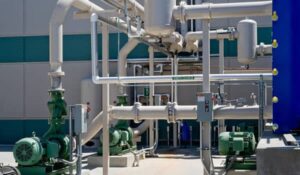Guide to Sourcing Quality HVAC Parts for Residential and Commercial Systems
When it comes to maintaining the efficiency and longevity of HVAC systems, the importance of sourcing high-quality parts cannot be overstated. Whether you’re managing a small residential unit or a complex commercial setup, the components you choose will significantly impact the performance, energy efficiency, and durability of your system. While Alliance Comfort Systems, Inc specializes in commercial and industrial HVAC solutions, understanding the broader landscape of HVAC parts is essential for any facility manager, contractor, or homeowner.
This guide will explore the critical aspects of sourcing quality HVAC parts, focusing on how to find the right components for both residential and commercial systems. By understanding the unique needs of different HVAC setups and the importance of choosing reliable parts, you’ll be better equipped to keep your system running smoothly.
Understanding HVAC Systems: Residential vs. Commercial
Before diving into the specifics of sourcing HVAC parts, it’s essential to recognize the differences between residential and commercial HVAC systems. While both systems serve the same fundamental purpose—heating, ventilation, and air conditioning—they differ significantly in scale, complexity, and the demands placed on them.
Residential HVAC Systems
Residential HVAC systems are typically smaller and less complex than their commercial counterparts. They are designed to heat or cool individual homes or small apartments, usually focusing on comfort and energy efficiency. Common residential HVAC systems include:
- Split Systems: These consist of an outdoor unit (compressor and condenser) and an indoor unit (evaporator and air handler). Split systems are popular in homes due to their efficiency and ability to control temperatures in different zones.
- Heat Pumps: Heat pumps are versatile systems that can provide both heating and cooling by transferring heat between the indoors and outdoors. They are especially popular in moderate climates.
- Packaged Systems: In smaller homes or those with limited space, packaged systems, which combine the compressor, condenser, and evaporator in a single unit, are a convenient option.
- Ductless Mini-Split Systems: These systems offer flexible heating and cooling solutions without the need for ductwork, making them ideal for retrofitting older homes or adding climate control to specific rooms.
Commercial HVAC Systems
Commercial HVAC systems are designed to handle the heating and cooling needs of larger buildings, such as offices, warehouses, factories, and retail spaces. These systems must be robust, reliable, and capable of maintaining consistent temperatures across large areas. Key characteristics of commercial HVAC systems include:
- Scale and Capacity: Commercial systems are much larger and more powerful, designed to regulate the climate in extensive spaces with varying temperature zones.
- Complexity: These systems often involve multiple units working together, including rooftop units (RTUs), chillers, boilers, and air handlers. They may also integrate advanced control systems to optimize energy use.
- Customization: Commercial HVAC systems are often customized to meet the specific needs of the building, considering factors like occupancy, layout, and operational hours.
- Maintenance Needs: Due to their complexity and the demands placed on them, commercial HVAC systems require more frequent and specialized maintenance, making the sourcing of high-quality parts even more critical.
The Importance of Quality HVAC Parts
Regardless of whether you’re dealing with a residential or commercial system, the quality of the HVAC parts you use will have a significant impact on your system’s performance. Here’s why sourcing high-quality parts is so essential:
1. System Efficiency
High-quality HVAC parts are engineered to work seamlessly within your system, ensuring that it operates at peak efficiency. Efficient systems consume less energy, which can lead to lower utility bills and a reduced environmental footprint. For commercial systems, where energy consumption can be substantial, the efficiency of every component plays a crucial role in overall operational costs.
2. Reliability and Durability
Using inferior parts can lead to frequent breakdowns, increased maintenance costs, and even system failure. Quality parts, on the other hand, are designed to withstand the demands of your system, providing reliable performance over a longer lifespan. This is particularly important in commercial settings, where HVAC downtime can disrupt business operations and lead to significant losses.
3. Compatibility
When sourcing HVAC parts, it’s crucial to ensure they are compatible with your existing system. High-quality parts from reputable manufacturers are designed to meet specific standards and specifications, reducing the risk of incompatibility issues that could lead to inefficiencies or damage to your system.
4. Safety
HVAC systems involve complex electrical and mechanical components. Using substandard parts can compromise the safety of your system, potentially leading to hazards like electrical fires, refrigerant leaks, or carbon monoxide poisoning. Quality parts undergo rigorous testing to meet safety standards, ensuring that your system operates safely.
5. Long-Term Savings
While high-quality parts may come with a higher upfront cost, they often lead to long-term savings. Fewer repairs, lower energy consumption, and a longer system lifespan mean that investing in quality parts can ultimately save you money over time.
Where to Source Quality HVAC Parts
Finding a reliable supplier is the first step in sourcing high-quality HVAC parts. The following are key considerations when choosing where to buy your parts:
1. Reputation and Experience
Choose suppliers with a strong reputation and years of experience in the HVAC industry. Companies like Alliance Comfort Systems, Inc have built their reputation by consistently providing high-quality parts and exceptional customer service. Experienced suppliers are more likely to offer a wide range of parts and have the expertise to help you choose the right components for your system.
2. Specialization
Suppliers that specialize in HVAC parts for specific types of systems, such as commercial or industrial HVAC, can offer more targeted solutions and expert advice. For example, Alliance Comfort Systems, Inc specializes in commercial and industrial HVAC systems, making us the go-to source for businesses in need of robust, reliable parts.
3. Product Range
A good supplier should offer a comprehensive range of HVAC parts, including those for both residential and commercial systems. This allows you to source all the components you need from one place, saving time and ensuring compatibility across your system.
4. Quality Assurance
Look for suppliers that source their parts from reputable manufacturers known for their commitment to quality. Suppliers should be able to provide information on the brands they carry and any warranties or certifications associated with their products.
5. Technical Support and Customer Service
Reliable technical support is crucial, especially when dealing with complex commercial systems. Your supplier should offer expert guidance on part selection, installation, and troubleshooting. Additionally, responsive customer service is essential for handling orders, returns, and any issues that may arise.
6. Convenience and Accessibility
Consider the supplier’s location and how quickly they can deliver parts to your site. For businesses in the Louisville, KY area, Alliance Comfort Systems, Inc is conveniently located at 7200 Distribution Dr, Louisville, KY 40258, allowing for quick access to the parts you need. We also offer easy communication through our toll-free number +1 502 384 8500 and email at ACS.receptionist@AllianceComfortSys.com.
How to Ensure You’re Getting Quality HVAC Parts
Once you’ve identified a reliable supplier, there are additional steps you can take to ensure you’re getting the best quality HVAC parts:
1. Verify Manufacturer Credentials
Check the credentials of the manufacturers whose parts you’re purchasing. Reputable manufacturers will have a history of producing high-quality components that meet industry standards. Look for brands that are well-known in the HVAC industry and have positive reviews from other professionals.
2. Request Documentation
Ask your supplier for any relevant documentation that accompanies the parts, such as product specifications, safety data sheets, and warranties. This information can provide valuable insights into the quality and reliability of the parts.
3. Inspect Parts Upon Delivery
When your parts arrive, inspect them for any signs of damage or defects. Check that the parts match your order and that they meet the specifications provided by the manufacturer. If there are any issues, contact your supplier immediately to arrange for a replacement.
4. Consider Energy Efficiency Ratings
For parts that impact energy consumption, such as compressors, motors, and control systems, consider their energy efficiency ratings. Higher efficiency ratings can lead to lower operating costs and reduced environmental impact.
5. Seek Expert Advice
If you’re unsure about which parts to choose, don’t hesitate to seek advice from HVAC professionals. At Alliance Comfort Systems, Inc, our team of experienced technicians can provide expert guidance on selecting the right parts for your system, ensuring optimal performance and compatibility.
Sourcing quality HVAC parts is crucial for maintaining the efficiency, reliability, and safety of your heating, ventilation, and air conditioning systems. Whether you’re managing a residential unit or a complex commercial setup, the parts you choose will have a direct impact on your system’s performance and longevity.
By working with a reputable supplier like Alliance Comfort Systems, Inc, you can ensure that you’re getting high-quality parts that meet the specific needs of your system. With a focus on commercial and industrial HVAC solutions, we offer a wide range of reliable components, expert support, and exceptional customer service.
Located at 7200 Distribution Dr, Louisville, KY 40258, Alliance Comfort Systems, Inc is dedicated to providing the best HVAC parts and services to our clients. Contact us today at +1 502 384 8500 or via email at ACS.receptionist@AllianceComfortSys.com to learn more about how we can support your HVAC needs.
How to Identify and Replace Essential HVAC Parts for Improved Efficiency and Longevity
Maintaining an HVAC system’s efficiency and longevity is crucial for any commercial or industrial operation. Proper identification and timely replacement of essential HVAC parts play a vital role in ensuring that your system runs smoothly, minimizes downtime, and reduces energy costs. Alliance Comfort Systems, Inc, located at 7200 Distribution Dr, Louisville, KY 40258, specializes in providing high-quality HVAC parts and services tailored to commercial and industrial clients. Our expertise can help you keep your system operating at peak performance.
In this comprehensive guide, we will explore the essential HVAC parts that require regular attention, how to identify when they need replacement, and the steps you can take to ensure your HVAC system remains efficient and durable.
Understanding the Role of Essential HVAC Parts
HVAC systems are complex assemblies of various components that work together to regulate indoor temperature, humidity, and air quality. Each part plays a specific role in the system’s overall functionality. When one component fails or operates inefficiently, it can lead to increased energy consumption, reduced comfort, and potentially costly repairs.
Identifying and replacing key HVAC parts before they fail is crucial for maintaining system performance. Here are some of the most critical components that require regular monitoring:
- Filters
- Thermostats
- Compressors
- Condenser Coils
- Evaporator Coils
- Blower Motors
- Capacitors
- Belts and Bearings
- Refrigerant Lines
- Ductwork
Each of these parts has specific signs of wear or failure that should prompt a replacement. Let’s explore each component in detail.
1. Filters
Role in the System:
Filters are responsible for trapping dust, debris, and other particles before they enter the HVAC system. They are crucial for maintaining indoor air quality and preventing contaminants from damaging sensitive components like the evaporator and condenser coils.
Signs of Wear:
- Increased dust accumulation around vents.
- Reduced airflow through the system.
- Higher energy bills due to the system working harder to push air through clogged filters.
- Poor indoor air quality, leading to discomfort for occupants.
Replacement Frequency:
Filters should be checked regularly and replaced every 1 to 3 months, depending on the system’s usage and the environment. In commercial and industrial settings, more frequent replacements may be necessary due to higher levels of airborne particles.
2. Thermostats
Role in the System:
Thermostats control the HVAC system’s temperature settings, ensuring that the building maintains the desired climate. They also play a role in energy efficiency by regulating when the system should turn on and off.
Signs of Wear:
- Inconsistent temperature readings.
- The system fails to turn on or off as scheduled.
- Unusually high energy bills due to the system running longer than necessary.
- The thermostat display is unresponsive or shows incorrect information.
Replacement Frequency:
Thermostats typically last around 10 years. However, if you notice any of the above issues, it may be time to replace the thermostat with a newer, more energy-efficient model.
3. Compressors
Role in the System:
The compressor is the heart of the HVAC system, responsible for circulating refrigerant between the evaporator and condenser coils. It plays a crucial role in the cooling process by compressing the refrigerant and converting it into a high-pressure gas.
Signs of Wear:
- The system struggles to cool the building, even when running continuously.
- Strange noises, such as grinding or clicking, coming from the outdoor unit.
- The compressor frequently cycles on and off, indicating potential electrical issues.
- Refrigerant leaks around the compressor unit.
Replacement Frequency:
Compressors are designed to last 10-15 years, but they may need replacement sooner if the system is not properly maintained. Regular maintenance, such as checking refrigerant levels and cleaning the coils, can extend the compressor’s lifespan.
4. Condenser Coils
Role in the System:
Condenser coils are located in the outdoor unit of the HVAC system and are responsible for releasing the heat absorbed from inside the building. They allow the refrigerant to cool down and condense back into a liquid form.
Signs of Wear:
- The system takes longer than usual to cool the building.
- The outdoor unit is hot to the touch or emits a burning smell.
- Visible dirt, grime, or corrosion on the coils.
- Higher energy bills due to the system working harder to expel heat.
Replacement Frequency:
Condenser coils can last up to 20 years with proper maintenance, but they should be cleaned regularly to prevent dirt and debris buildup, which can lead to inefficiency and failure. If the coils are severely damaged or corroded, replacement is necessary.
5. Evaporator Coils
Role in the System:
Evaporator coils are located inside the HVAC unit and are responsible for absorbing heat from the indoor air. They work in conjunction with the condenser coils to complete the cooling cycle.
Signs of Wear:
- Reduced cooling efficiency, leading to uneven temperatures throughout the building.
- Ice buildup on the coils or surrounding components.
- Musty odors coming from the vents, indicating mold growth on the coils.
- The system runs continuously without reaching the set temperature.
Replacement Frequency:
Evaporator coils should be inspected annually and cleaned as needed. They can last 10-15 years, but if you notice signs of wear, especially ice buildup or mold, replacement may be necessary.
6. Blower Motors
Role in the System:
The blower motor is responsible for circulating air throughout the HVAC system and into the building. It ensures that conditioned air reaches all areas of the space, maintaining consistent temperatures.
Signs of Wear:
- The system produces little to no airflow, even when the fan is running.
- Strange noises, such as squealing or grinding, coming from the blower unit.
- The motor overheats, causing the system to shut down unexpectedly.
- The blower runs continuously or fails to turn on, indicating electrical issues.
Replacement Frequency:
Blower motors typically last 10-20 years, depending on the system’s usage and maintenance. If the motor shows signs of wear, it may need to be replaced to prevent further damage to the HVAC system.
7. Capacitors
Role in the System:
Capacitors are electrical components that provide the necessary power to start and run the compressor, blower motor, and fan motor. They store and release energy as needed to keep the system running smoothly.
Signs of Wear:
- The system fails to start or struggles to run smoothly.
- A humming sound coming from the outdoor unit, indicating a failing capacitor.
- The system turns on and off frequently, leading to inconsistent cooling.
- The capacitor is visibly swollen or leaking fluid.
Replacement Frequency:
Capacitors can last 5-10 years, but they are prone to wear and may need replacement sooner if the system experiences frequent electrical issues. Regular inspections can help identify failing capacitors before they cause significant damage.
8. Belts and Bearings
Role in the System:
Belts and bearings are essential for the smooth operation of the HVAC system’s motors and fans. They help transfer power and reduce friction between moving parts.
Signs of Wear:
- Squealing or grinding noises coming from the system, indicating worn belts or bearings.
- The system vibrates excessively during operation.
- Belts appear cracked, frayed, or loose.
- The system’s performance deteriorates due to increased friction and wear on the bearings.
Replacement Frequency:
Belts and bearings should be inspected regularly and replaced as needed. Belts typically last 3-5 years, while bearings can last longer with proper lubrication and maintenance. Replacing these components before they fail can prevent further damage to the system.
9. Refrigerant Lines
Role in the System:
Refrigerant lines carry the refrigerant between the evaporator and condenser coils, facilitating the heat exchange process. Properly functioning refrigerant lines are essential for maintaining the system’s cooling efficiency.
Signs of Wear:
- The system struggles to cool the building, even when running continuously.
- Ice buildup on the refrigerant lines, indicating a potential leak.
- Visible damage or corrosion on the lines.
- The system emits a hissing sound, suggesting a refrigerant leak.
Replacement Frequency:
Refrigerant lines should be inspected regularly for signs of wear or damage. While they can last the life of the system, any leaks or damage should be addressed immediately to prevent further issues.
10. Ductwork
Role in the System:
Ductwork is responsible for distributing conditioned air throughout the building. It plays a crucial role in maintaining consistent temperatures and air quality.
Signs of Wear:
- Uneven temperatures in different areas of the building, indicating leaks or blockages in the ductwork.
- Increased dust or debris in the air, suggesting gaps or holes in the ducts.
- Higher energy bills due to air loss in damaged ducts.
- The system struggles to maintain the desired temperature, leading to longer run times.
Replacement Frequency:
Ductwork can last 10-15 years, but it should be inspected regularly for signs of wear or damage. Sealing gaps, cleaning ducts, and replacing damaged sections can improve the system’s efficiency and air quality.
How Alliance Comfort Systems, Inc Can Help
At Alliance Comfort Systems, Inc, we understand the importance of maintaining your commercial or industrial HVAC system. Our team of experienced technicians can help you identify and replace essential HVAC parts to ensure your system operates at peak efficiency. We offer a wide range of high-quality HVAC parts and provide expert advice on selecting the right components for your needs.
Address
7200 Distribution Dr, Louisville, KY 40258Phone: (502) 384-8500 Email: ACS.receptionist@AllianceComfortSys.com
Opening Hours
| Monday | 9:00 a.m. – 5:00 p.m. |
| Tuesday | 9:00 a.m. – 5:00 p.m. |
| Wednesday | 9:00 a.m. – 5:00 p.m. |
| Thursday | 9:00 a.m. – 5:00 p.m. |
| Friday | 9:00 a.m. – 5:00 p.m. |
| Saturday | Closed |
| Sunday | Closed |











